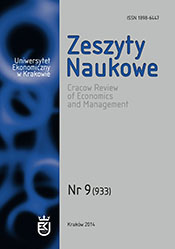The Organisational Engagement of Manual Labourers in a Transnational Corporation
DOI:
https://doi.org/10.15678/ZNUEK.2014.0933.0905Słowa kluczowe:
zaangażowanie organizacyjne, efekty pracowników, retencja pracowników, pracownicy transnarodowiAbstrakt
Tytuł artykułu: Zaangażowanie organizacyjne pracowników operacyjnych w korporacji transnarodowej
Silna konkurencja na rynkach globalnych oraz niewystarczająca podaż pracowników operacyjnych skłaniają korporacje transnarodowe w Tajlandii do poszukiwania odpowiednich strategii zmniejszania kosztów pracy i podnoszenia produktywności pracy. W opracowaniu skoncentrowano się na zbadaniu czynników wpływających na efekty pracy i zaangażowanie pracowników operacyjnych. Badania empiryczne przeprowadzone zostały na próbie pracowników w fabryce należącej do korporacji transnarodowej działającej w branży spożywczej. Ich zakres obejmował analizę efektywności pracy, zaangażowania organizacyjnego oraz retencji pracowników. Na tej podstawie sformułowano wnioski dotyczące rekrutacji, podnoszenia efektywności pracy i retencji pracowników.
Downloads
Bibliografia
Ariss S. S., Timmins S. A. (1989), Employee Education and Job Performance: Does Education Matter?, “Journal of Public Personnel Management”, 18(2): 100–112.
Avery D. R., McKay P. F., Wilson D. C. (2007), Engaging the Aging Workforce: The Relationship between Perceived Age Similarity, Satisfaction with Coworkers, and Employee Engagement, “Journal of Applied Psychology”, 92(6): 1542–1556, http://dx.doi.org/10.1037/0021-9010.92.6.1542.
Benggtson C., Vedin J. A., Grimby G., Tibblin G. (1978), Maximal Work Performance Test in Middle-aged Women: Results from a Population Study, “Scandinavian Journal of Clinical and Laboratory Investigation”, 38(2): 181–188.
Bevan S. (1997), Quit Stalling (Retention), “People Management”, 3(23): 32–35.
Birren J. E., Schaie K. W. (2001), Handbook of the Psychology of Aging, Gulf Professional Publisher, London.
Campos N. F., Kinoshita Y. (2003), Why Does FDI Go Where It Goes? New Evidence from the Transition Economies, https://www.imf.org/external/pubs/ft/wp/2003/wp03228.pdf, accessed: January 2, 2014.
Chandrasekar K. (2011), Workplace Environment and Its Impact on Organizational Performance in Public Sector Organizations, “International Journal of Enterprise Computing and Business Systems”, 1(1), www.ijecbs.com/January2011/N4Jan2011.pdf, accessed: December 20, 2013.
Dale Carnegie Training (2012), What Drives Employee Engagement and Why It Matters, www.dalecarnegie.com/assets/1/7/driveengagement_101612_wp.pdf, accessed: November 29, 2013.
Eby L. T., Adams D. M., Russel J. E. A., Gaby S. H. (2000), Perceptions of Organisational Readiness for Change. Factors Related to Employees’ Reaction to the Implementation of Team-based Selling, “Human Relations”, 53(3): 419–442, http://dx.doi.org/10.1177/0018726700533006.
Ernst & Young (2012), Beyond Asia: Strategies to Support the Quest for Growth/Thailand Highlights, www.bot.or.th/Thai/FinancialMarkets/ThaiDirectInvertment/Document/ThailandHighlights_ ErnstAndYoung.pfd, accessed: January 2, 2014.
Haynes B. P. (2008), An Evaluation of the Impact of the Office Environment on Productivity, “Journal of Facilities”, 26(516): 178–190.
Higginbotham J. S. (1997), The Satisfaction Equation, “Research & Development”, 39(10): 1–9.
Huang Y. H., Robertson M. M., Chang K. I. (2004), The Role of Environmental Control on Environmental Sastisfaction, Communication, and Psychological Stress: Effect of Office Ergonomics Training, “Environment and Behavior”, 36(5): 617–638, http://dx.doi.org/10.1177/0013916503262543.
Huguet J. W., Chamratrithirong A., Richter K. (2011), Thailand Migration Profile (in:) J. W. Huguet, A. Chamratrithirong (eds), Thailand Migration Report 2011, International Organization for Migration, Bangkok.
James J. B., Swanberg J. E., McKechnie S. P. (2007), Responsive Workforces for Older Workers: Job Quality, Flexibility and Employee Engagement, The Center for Aging and Work/Workplace Flexibility at Boston College, Chestnut Hill, MA.
Kujala V., Remes J., Ek E., Tammelin T., Laitinen J. (2005), Classification of Work Ability Index among Young Employees, “Journal of Occupational Medicine”, 55(5): 399–401.
Linz S. (2002), Job Satisfaction among Russian Workers, http://ssm.com/abstract-313641orDQI:10.2139/ssm.313641, accessed: December 15, 2013.
McBey K., Karakowsky L. (2001), Examining Sources of Influence on Employee Turnover in the Part-time Context, “Journal of Career Development International”, 21(3): 136–144.
Mohr R. (1996), Office Space Is a Revenue Enhancer, Not an Expense, “National Real Estate Investor”, 38(7): 46–47.
Norman M. (2012), 6 Ways to Retain Remote Workers – and Make Them Feel Part of the Team, http://www.tlnt.com/2012/03/20/6-ways-to-retain-remote-workers-and-makethem-feel-part-of-the-team, accessed: December 1, 2013.
Padoa C. (2012), The Other 3 R’s: Recognition, Remuneration, and Retention, http://bx.businessweek.com/employeeretention/view?url=http%3A%2F%2Fwww.Executionandstrategy.com%2F2012%2F06%2Fother-3-rs-recognition-remuneration-and.html, accessed: December 5, 2013.
Patterson M. G., West M. A., Lawthorn R., Nickell S. (1997), Impact of People Management Practices on Business Performance, Issues in People Management No. 22, Institute of Personnel and Development, London.
Ryan R. M., Deci E. L. (2000), Self-determination Theory and the Facilitation of Intrinsic Motivation, Social Development, and Well-being, “American Psychologist”, 55(1): 68–78, http://dx.doi.org/10.1037/0003-066x.55.1.68.
Shaiful A. K., Kamaruzaman J., Hassan A., Mohamad I., Kamsol M. K., Norhasimah A. R. (2009), Gender as Moderator of the Relationship between OCB and Turnover Intention, “Journal of Asian Social Science”, 5(6): 108–117.
Shult K. S., Adam G. A. (2007), Aging and Work in the 21st Century, Routledge Publisher, New Jersey.
Smedley K., Whitten H. (2006), Age Matters: Employing, Motivation, and Managing Older Employees, Gower Publishing, Hampshire, UK.
Yamane T. (1967), Elementary Sampling Theory, Prentice-Hall, Englewood Cliffs, NJ.
Yearta S. K. (1995), Does Age Matter?, “Journal of Management Development”, 14(7): 28–35.




